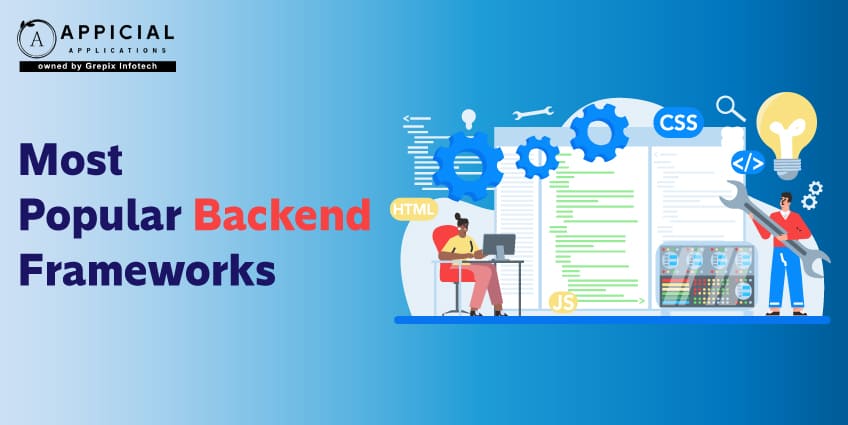
Most Popular Backend Frameworks
The variety of the most commonly used languages among software developers remains huge. According to Statista, every fifth developer employs at least one of 12 different programming languages, ranging from PHP (21,98%) and C (21,01%) to JavaScript (64%) and HTML/CSS (56%).
Being a good developer in the current environment requires keeping up with current software development trends, so it's critical to keep track of the most widely used backend frameworks and swiftly adapt to changing requirements.
This blog discusses well-known backend frameworks and offers some useful advice on which one could be best for you based on your level of experience and other considerations.
What Are Backend Frameworks?
A backend framework essentially offers a standardized, reusable platform for developing apps. By offering ready-made solutions for frequent activities, such as linking databases or enabling user logins, a framework can accelerate development.
In the ever-evolving landscape of software development, this blog explores the most popular backend frameworks that empower developers to build robust and scalable applications. From Django and Ruby on Rails to Node.js and Laravel, the post provides an overview of each framework's strengths and applications. This information equips developers with the knowledge needed to choose the right backend framework for their specific project requirements.
Much like WordPress or Drupal can streamline a website’s creation process, a backend framework makes it easy to build complex applications quickly.
Why Use Backend Frameworks?
When creating new software, developers can save time by using frameworks. Furthermore, a backend framework offers an architecture that incorporates every element required by your platform and enables a web service.
It is easy to understand why so many businesses prefer to use these technologies when you consider the time and resources required to construct each component of a web service from scratch. And as a result of the widespread application of software architectural techniques that have established their efficiency and adaptability, a list of the most popular backend frameworks emerged.
Most Popular Backend Frameworks
Developers can use a variety of frameworks on different platforms, including .NET, Java, Python, and Ruby. The ideal option for your organization will depend on the demands it is facing right now.
For instance, certain platforms provide greater freedom when it comes to applying various functionalities to various apps. Additional factors might include the size of your company and the level of support each provider offers. For the framework you've chosen to adopt, you may also want to determine whether or not your present team employs a specific programming language.
After looking over these elements, you should have a clearer notion of the next step you should take when choosing a backend framework.
And this blog guidance will assist in exposing the benefits and drawbacks of the most widely used backend frameworks:
- Django
- Ruby on Rails
- Laravel
- ASP.NET
- Flutter
- NodeJS
- Golang
1. Django from Python
Two Python programmers founded Django to offer a set of tools for quickly creating scalable online applications. And judging by the millions of developers using Django today, they undoubtedly hit the mark. Throughout its existence, the framework has undergone several significant changes, ensuring that it remains current and applicable.
Advantages:
- Usability: It’s easy to master and start using Django for your project.
- Rich functionality: By choosing this option from the most popular backend frameworks, your program can gain several fantastic functionalities. Additionally, you can use it to build platforms, messengers, and analytical tools, among other things.
- Scalability: If you anticipate experiencing big demand spikes for your website, Python's Django is a wise choice.
- Security: The framework features built-in defenses against the most prevalent security threats and a safe user authentication process.
Disadvantages:
- Limitations: When it comes to adding new features, this most common backend framework is not very flexible. Additionally, specific patterns must be followed during the deployment phase.
- Need for planning: Even though it’s easy to start with Django, its application requires tremendous effort, mastery, and extensive planning.
2. Ruby on Rails
Even though it has been around for almost 20 years, Ruby on Rails is still one of the most widely used backend frameworks available today. The fact that it scales effectively as your organization expands is its greatest benefit. It was created with scalability and growth in mind. Because Ruby on Rails is very malleable by nature, it can support your project over time with little to no coding changes or redesigns.
Advantages:
- Speed: Almost every part of your software can have its pre-built plugin or module, so building it will be fast.
- Transparency: Ruby on Rails standardizes everything to make your project as easy to understand and reliable as possible.
- Free of charge: Ruby on Rails is an open-source framework that is free for anyone to use and has an accessible module library.
Disadvantages:
- Can't handle high demand: If your business will grow to handle hundreds of thousands of requests per second, you should use another framework from the very beginning.
- Standardized features only: Since this representative of backend web frameworks defines not only functions but also dependencies between them in one way only, it's hard to implement something unusual with it. Also, it means that each mistake will cost you extra money by ruining dependencies and building everything from scratch.
Also Read: App Development Cost: 8 Hidden Costs of Mobile Apps & How to Handle Them
3. Laravel
Laravel, which was introduced in 2011, is one of the most widely used PHP frameworks for creating web applications. Laravel is a platform-neutral framework that can be used to create applications of any size using object-oriented programming (OOP) methods. It is sometimes known as Larajole after its founder, Taylor Otwell. Namespaces, auto-loading capabilities, extensible template engines with plugins, thorough documentation, and support for microservices are notable characteristics.
Advantages:
- Several useful pre-built features include: You may rely on Laravel's framework for user authentication, notifications, and API connections with email services. It is simple and convenient to use the technique.
- Caching tools and log handling: Tools for data caching and log handling include Redis and Memcached, as well as a variety of log handlers.
- Tools for testing: Laravel has PHP support and a phpunit.xml file that enable the simulation of users’ behavior for testing purposes.
Disadvantages:
- Complicated: Due to the many intricate and stringent rules you must adhere to, learning Laravel can be challenging.
- Lack of support: Due to the growing problems, support from Laravel is not always available.
4. ASP.NET
As a Windows-based backend platform for web development, Microsoft released ASP.NET in 2000. It mostly employs C#. These days, it is continually updated with fresh features that originate from Microsoft. Because of this, Visual Studio's cross-platform interoperability plays a crucial role.
Advantages:
- Minimum coding: The majority of functionalities in ASP.NET Core are already pre-configured, which simplifies and expedites development.
- Cross-platform: ASP.NET, which is based on C#, is effective for creating cross-platform web apps. Despite being widely used in enterprise applications, it can also be easily customized.
Disadvantages:
- Lack of control: When working with ASP.NET, Microsoft's rules and control over their actions impose restrictions on developers' freedom and creativity.
- Price for licensing: Licensing is necessary for all core modules, not just supplemental ones.
5. Flutter
The most widely used backend framework for creating apps for Android and iOS is called Flutter. The key benefit of Flutter is that you can utilize a single codebase, which saves you time from having to manage two different apps. This implies that you only need to make changes once, and they will immediately be reflected on both platforms.
Advantages:
- Wide applicability: The best backend framework for mobile development is Flutter, which has many uses. In addition to Android and iOS, you can also use it to create apps for Google Fuchsia, Windows, Linux, Mac, and other platforms.
- Fast changes: Flutter enables changes to the running code, eliminating the need to reboot an app to test upgrades.
Disadvantages:
- Compatibility problems: Compatibility issues: Flutter updates coincide with the introduction of iOS and Android updates.
6. NodeJS
For creating server-side web applications, Node.js is an open-source, cross-platform JavaScript runtime environment. Node.js is ideal for data-intensive, real-time applications that operate across dispersed devices because it uses an event-driven, non-blocking I/O style that makes it lightweight and efficient.
Advantages:
- Error handling: NodeJS identifies errors and fixes them right away using the throw-catch methodology.
- Easy to learn: The fact that JavaScript is the most widely used programming language in the world makes it simpler to learn NodeJS even with little JavaScript expertise.
Disadvantages:
- Event-callback mechanism: Concurrency is avoided in NodeJS by doing everything in a linear order.
7. Golang
Google developed the programming language Go, which is simple, organized, and efficient. It is so well-liked that major cloud providers like Heroku and AWS already offer it. Although Golang isn't yet among the most popular backend frameworks, its use is growing while It already works with NodeJS.
Advantages:
- Concurrency: Because of its straightforward thread communication mechanism, which can manage running multiple functions simultaneously, Golang is a good solution for large software projects.
- Scalability: Go handles parallel threads efficiently and dependably with goroutines.
Disadvantages:
- Complicated: Go is a difficult language to learn since it has so many unique rules and conventions.
How Do I Pick From the Most Well-Known Backend Frameworks?
Appicial Applications is a leading taxi app development company provides ready-to-use, fully customized on-demand taxi app solutions for business owners. As you can see, choosing the best backend framework among them might be challenging. To make the best decision, in addition to learning the numerous requirements, you should analyze your present needs and project your future development.
Feel free to get in touch with a skilled development team at Intellectsoft if you feel overwhelmed by this process and ask for our assistance! You can assign us many areas of responsibility within a software development project using this service, including:
- Resource planning
- Team composing
- Staff motivation
- IT Infrastructure
- Relevant training, and many more.
Speak with our specialists, and we'll assist you in choosing the top backend framework from the most popular ones!





